


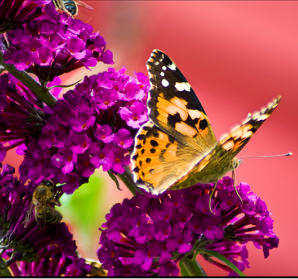
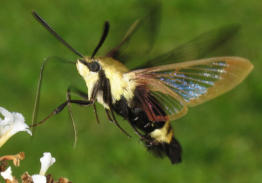
HUMING BIRD HAWK MOTH
This day flying moth can often be seen in gardens feeding on geraniums, honeysuckle, petunias or verbena. It is equipped with a
long tongue which it uses to drink nectar.
Like a humming bird they hover in front of flowers as they feed. Their wings flap so fast they appear to be on fire. In fact this is the
orange coloured hind-wings, showing up as a blur. The moth also makes a throbbing noise as it hovers.
Found throughout the U.K. (even on the Shetland Islands) but the majority are seen in southern England. Can be seen as early as
March. It's possible some hibernate in Britain during the winter, but the majority fly in from Mediterranean countries between May
and September.
Alcea (Hollyhock)
Aquilegia
Buddliea
Buddliea Altternifolia
Delphinium
Dianthus (Carnations)
Echinacea
Eryngium
Geranium
Gerbera
Geum
Gypsophila
Herbs
Hosta
Iris
Kniphofia
Lantana
Leucanthemum
Lupins
Monarda
Penstemon
Peony
Phlox
Rudbeckia
Sidalcea
Sysirinchium
Tanacetum (Pyrethrum)
Thalictrum
Trollius
Verbena
About Us
Where To Find Us
Contact Us
GATEKEEPER
Widespread and common throughout England and Wales, and along the south coast of Ireland. Orange and brown, with black eyespot on forewing tip.
Eyespots have two white pupils, not one, as in the Meadow Brown. Gatekeeper is also smaller and more orange with row of tiny white dots on hind underwings.
As its English names suggest, the Gatekeeper (also known as the Hedge Brown) is often encountered where clumps of flowers grow in gateways and along
hedgerows and field edges. It is often seen together with the Meadow Brown and Ringlet, from which it is easily distinguished when basking or nectaring with
open wings.
The colour and patterning of the wings are very variable and about a dozen aberrations have been named. Favourite nectar sources include Wild Marjoram,
Common Fleabane, ragworts, and Bramble.
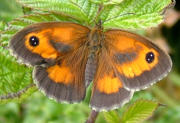
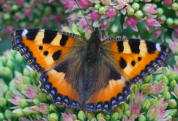
SMALL TORTOISESHELL
One of the commoner garden butterflies throughout the UK, the small tortoiseshell is orange and black with a row of blue crescents around the wing edges.
Underneath, they are camouflaged dark grey and brown. Adults emerge from hibernation on the first warm spring days and look for mates.
Females usually lay their eggs on tender, young stinging nettles in batches of 60 to 100. Caterpillars hatch after about 10 days and spin a dense web over the
plant’s growing tip. The caterpillars live communally for most of their lives, dispersing to pupate. Adults often hibernate in houses, outbuildings and sheds.
Caterpillars are bristly and black with two discontinuous yellow lines along their sides. Their bright colours warn predators that they are poisonous. Adults drink
nectar from flowers: buddleia is a favourite.
BRITISH BUTTERFLIES
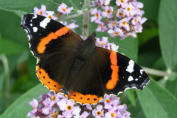
RED ADMIRAL
The Red Admiral is a frequent visitor to gardens throughout the British Isles and one of our most well-known butterflies. This butterfly is unmistakable, with the
velvety black wings intersected by striking red bands.
This butterfly is primarily a migrant to our shores, although sightings of individuals and immature stages in the first few months of the year, especially in the south
of England, mean that this butterfly is now considered resident.
This butterfly can be found almost anywhere, from the seashore and town gardens, to the tops of the highest mountains.
The adults use a wide variety of nectar sources, including Buddleia, Ivy blossom and Bramble.
Adults may be seen throughout the year but there is build up in May and June as migrants arrive from the continent.
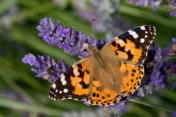
PAINTED LADY
This species originates from north Africa but Unfortunately, this species is unable to survive our winter in any stage. This is a real shame, for not only does this
species often arrive in large numbers, but is a welcome sight as it nectars in gardens throughout the British Isles in late summer.
Adults are first seen in late March as they start to arrive on our shores and numbers build up in May and June as further migrants arrive from the continent.
These breed and give rise to the next generation that peaks between mid-August and early October.
This butterfly can be found almost anywhere in Britainand this is one of the few species that can breed in intensive farmland since even these sites typically
contain a patch of Thistles, the primary food plant of this species.
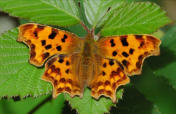
COMMA
The Comma is a fascinating butterfly. The scalloped edges and cryptic colouring of the wings conceal hibernating adults amongst dead leaves, while the larvae,
flecked with brown and white markings, bear close resemblance to bird droppings.
The species has a flexible life cycle, which allows it to capitalize on favourable weather conditions. However, the most remarkable feature of the Comma has
been its severe decline in the twentieth century and subsequent comeback. It is now widespread in southern Britain and its range is expanding northwards.
Open woodland and wood edges are the main habitats for both breeding and hibernation. Pre-hibernation individuals range more widely in search of nectar and
rotting fruit, and are seen regularly in gardens and many other habitats.
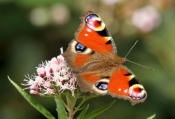
PEACOCK
Widespread in GB and Ireland and often seen in gardens. Red wings with black markings and distinctive eyespots on tips of fore and hind wings. Undersides of
the wings are very dark and look like dead leaves. A fairly large butterfly and a strong flyer.
The Peacock's spectacular pattern of eyespots, evolved to startle or confuse predators, make it one of the most easily recognized and best known species. It is
from these wing markings that the butterfly gained its common name.
Although a familiar visitor to garden buddleias in late summer, the Peacock's strong flight and nomadic instincts lead it to range widely through the countryside,
often finding its preferred habitats in the shelter of woodland clearings, rides, and edges.
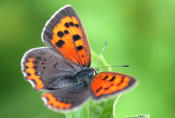
SMALL COPPER
The small copper is named after its bright copper coloured forewings, which are dotted with black spots and have a black border.
The Small Copper is a fast flying butterfly, and by daytime is almost constantly on the move. Even when feeding, it rests with its wings half open ready for a
lightning fast take off. Should another insect enter its air space, the small copper will swiftly drive it away.
These butterflies prefer sandy heathland, where their caterpillars can feed on their favourite food plant - sheep's sorrel.
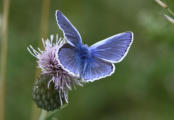
Common Blue
A small, widespread butterfly. Male has blue wings with black-brown border and thin white fringe. Female brown, similar to Brown Argus, but with blue dusting
near body. Unlike Adonis and Chalkhill Blues, the dark veins do not extend into white fringes of wing margins.
It occurs in a range of grassy places where its foodplants grow in sunny, sheltered situations on downland, coastal dunes and undercliffs, road verges, acid
grassland, and woodland clearings. It is also found in waste ground, disused pits and quarries, golf courses, and urban habitats such as cemeteries
The Common Blue is the most widespread blue butterfly in Britain
SPECKLED WOOD
The Speckled Wood is a common species found in woodland and scrub where dappled sunlight and areas of lush grass grow in damper areas and breeds in
woodland habitats lanes and tracks between tall hedgerows parks, gardens, and scrub. It seems to prefer slightly damp areas where there is tall grass and
some dappled shade.
These butterflies tend to be found, as their name suggests, in woodlands. They are normally seen fluttering in the shafts of sunlight which penetrate through the
woodland canopy.
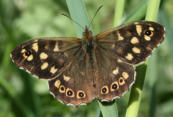
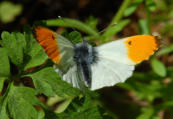
ORANGE TIP
Common and widespread. A medium sized butterfly of gardens and hedgerows. Males have white wings with orange wing tips. Females are white with black
wing tips. Both have mottled green underwings.
Orange-tips are seen commonly in early summer along hedgerows, road verges, and woodland edges.
The mottled pattern of yellow and black scales on the underside hindwings provides excellent camouflage when they roost on flower heads such as those of
Cow Parsley.
The butterfly is widespread in Ireland and southern Britain and has spread north rapidly over the past 25 years
A wide range of damp grassy habitats is used, including meadows, grassy areas in woodland, road verges and waterside habitats such as ditches and the
banks of rivers and canals








Wildlife
Pollinating insects



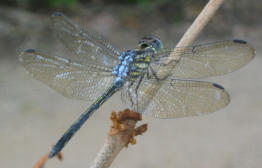
Dragonflies
Dragonflies are among the most ancient of living creatures sometimes called “The Devils Darning Needle”
From fossil records we know that these amazing insects were flying some 300 million years ago, before even
dinosaurs roamed the earth.
Over the centuries an extensive folklore has seen dragonflies revered in some cultures as symbols of strength,
regeneration and pure water, and feared in others as shamanistic creatures with supernatural powers.
However you might look upon them, it is true that they are a reliable indicator of good water quality, and recent
research finds they can be useful for the biological control of mosquitoes. They're also fascinating, beautiful and
quite harmless - they have no sting and will not attack or bite.
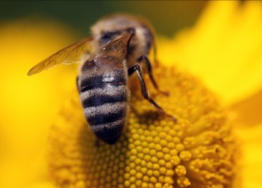
HONEYBEE
The Honeybees are truly the gardener's friend and are not the killer beast depicted in the cinema.
If not for them and the other species of bees, plant life would be reduced to mainly wind-pollinated grasses and
trees, as they pollinate most of the flowering plants. They have been doing this for millions of years, ever since the
angiosperm plants appeared and needed a vector to transfer pollen. Their value to food production is priceless as
they pollinate so many of the crops grown worldwide
Western Honeybee now kept for honey production. This honey was the main sweetener of food until sugar was
introduced, also the wax by-product provided the candles for illumination.
Honeybees are social insects and create elaborate nests, or hives, containing up to 20,000 individuals during the
summer months. (Domestic hives may have over 80,000 bees.) Working together in a highly structured social order,
each bee belongs to one of three specialized groups called castes - queens, drones and workers.
There is one queen in a hive and her main purpose in life is to make more bees.
The workers feed a few selected larvae a special food called "royal jelly" which causes them to become queens.
When active she can lay over 1,500 eggs per day and will live for two to eight years.
She is larger (up to 20mm) and has a longer abdomen than the workers or drones, which she controls by emitting chemical signals called "pheromones". She has chewing mouthparts
and her stinger which is curved with no barbs on it, can be used many times.
The drones are male so have no stinger. They live about eight weeks and only a few hundred are ever present in the hive. Their sole function is to mate with a new queen, if one is
produced in a given year. They are bigger than the workers and have bigger eyes than the other castes. At the end of the season they are considered non-essential and are driven out of
the hive to die.
Worker bees are all sterile females making up the vast majority of the colony and do all the different tasks needed to maintain and operate the hive. Young workers are called house bees
which work in the hive doing comb construction, brood rearing, tending the queen and drones, cleaning, temperature regulation (by beating their wings) and defending the hive. Older
workers are called field bees foraging outside the hive to gather nectar, pollen, water and certain sticky plant resins used in hive construction. Workers born early in the season will live
about 6 weeks while those born in the autumn will live until the following spring. Workers are about 12 mm long and highly specialized for what they do, with a structure called a pollen
basket (or corbiculum) on each hind leg, an extra stomach for storing and transporting nectar or honey and four pairs of special glands that secrete beeswax on the underside of their
abdomen. They have a straight, barbed stinger which can only be used once. It rips out of their abdomen after use, which kills the bee.